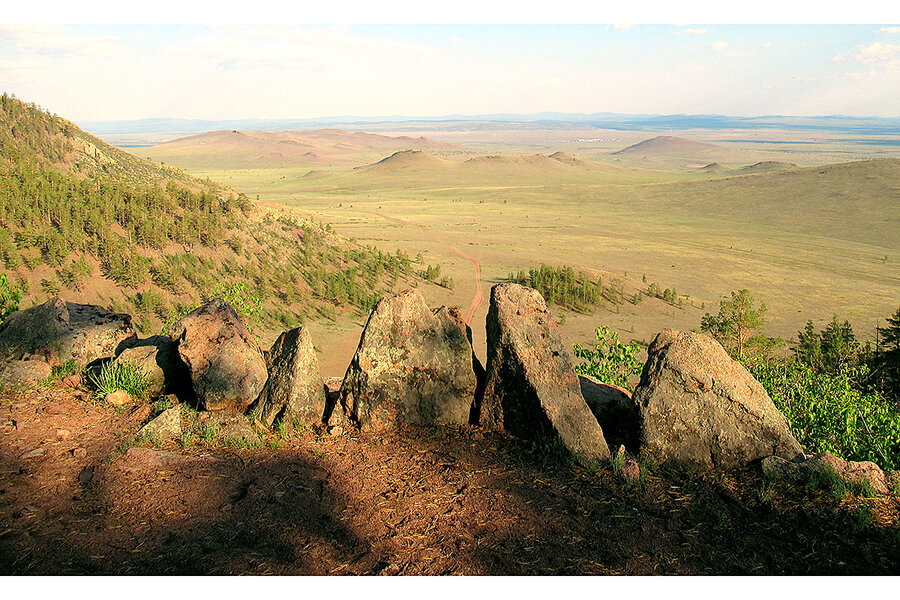Russia takes a new look at an old enemy: Genghis Khan
Loading...

| Mukhorshibirsky District, Russia
At its peak the Mongol Empire was the largest contiguous land empire in history, and it left its imprint everywhere, including present-day Russia. It took the Russians 200 years of hard struggle to unite themselves and throw off what they still refer to as the “Mongol yoke.” To this day, Russian schoolchildren learn that the Mongol occupiers brought nothing but pain, devastation, and humiliating subjugation. But that view is being challenged by historians and other thinkers here in Buryatia. They offer a more subtle interpretation that sees the Mongolian occupation as the impetus that shaped the enduring Russian state, with its highly centralized form of government dependent on an indisputable leader, its constant military-led expansionism, and its collective forms of social organization. “In Soviet times any mention of Genghis Khan was forbidden,” says Nikolai Kradin of the Institute of History, Archaeology and Ethnography of the Peoples of the Far-East. Today, “we’re coming to a more complex view of the Mongol conquest and its historical ramifications. Yes, they overran and destroyed civilizations, they were ruthless, but they integrated Russia into a vast empire.”
Why We Wrote This
It isn't easy for the conquered to see the contributions that a conqueror made to their country. It's even harder when that conqueror is Genghis Khan in Russia. But in the republic of Buryatia, the view is indeed shifting. Third in a five-part series.
In the south of Buryatia, near the present-day border with Mongolia, there is a mountain-sized rock outcropping known locally as the Merkit Fortress, which looks out over the arid, rolling steppe that gradually fades into the Gobi Desert a few hundred miles away.
According to legend, this formidable natural fortification was stormed more than 800 years ago by the forces of a young Mongol warlord who claimed his bride had been stolen by the Merkit tribe, which had made its home base here. He seized the rock, and went on to unite most of the nomadic Mongol tribes of northeast Asia, including the ancestors of today’s Buryats. Taking the name Genghis Khan, which means “universal ruler,” he flung his vast army of highly disciplined, horse-mounted shock troops to the south and west, conquering China, most of Central Asia and the Middle East, present-day Russia, and parts of Eastern Europe.
At its peak the Mongol Empire was the largest contiguous land empire in history, and it left its imprint everywhere. For the West its impact was mainly positive, because the Mongol-secured land passage to China – the fabled Silk Road – enabled travelers like Marco Polo to bring home Eastern wonders such as spices, silk, gunpowder, the compass, and the printing press.
Why We Wrote This
It isn't easy for the conquered to see the contributions that a conqueror made to their country. It's even harder when that conqueror is Genghis Khan in Russia. But in the republic of Buryatia, the view is indeed shifting. Third in a five-part series.
But Russian historians have traditionally treated it as an unmitigated catastrophe. The first wave of Mongol invaders smashed the European-like Kievan Rus state in present-day Ukraine, sending the survivors fleeing into the northern forests, where they congregated around small statelets like Moscow. It took the Russians 200 years of hard struggle to unite themselves and throw off what they still refer to as the “Mongol yoke.” To this day Russian schoolchildren learn that the Mongol occupiers, known as the “Golden Horde,” brought nothing but pain, devastation, and humiliating subjugation.
But that view is being challenged by historians and other thinkers here in Buryatia, and even some in Moscow. They offer a more subtle interpretation that sees the Mongol occupation as the impetus that shaped the enduring Russian state, with its highly-centralized form of government dependent on an indisputable leader, its constant military-led expansionism, and its collective forms of social organization.
“Putin is a khan. What he says is done. This is in the Mongolian tradition, and it’s not a European one at all,” says Alexei Gatapov, author of several books about Genghis Khan and Buryat history. “What I say may be controversial in Moscow, but we can see that quite clearly.”
Heirs of the empire
Russia and China are both products of centuries of Mongol rule, which took them in very different directions from Western development. In their 20th-century efforts to modernize, both adopted forms of communism that might not be recognizable to Karl Marx, but would probably get a nod of approval from Genghis Khan.
Despite the demise of communist ideology in the past quarter century and the wholesale adoption of capitalism by both Russia and China, geopolitical tensions with the West have not gone away, and may even be intensifying. Buryat scholars say they can understand why that is happening.
“Russia and China were both part of the great Mongol Empire, and we see the persistence of Mongol influence on the Russian state, military, and political culture to this day,” says Timur Dugarzhapov, editor of Novaya Buryatia, an independent political journal. “When Vladimir Putin and Chinese leaders meet today and find common geopolitical language, and China talks of using its economic might to reestablish the old Silk Road, they are reaching back to that historical experience. It was totally different from the Western one, and it created societies that are very unlike the West right down to their political DNA.”
Since the collapse of the USSR, Russia has embraced Western economic methods and also many other values, including a stated commitment to build democracy. But it remains founded upon a political system that Western critics now call “autocracy” in the same tone of voice they used to say “communism.” Those differences are not imaginary. China recently amended its constitution to allow Xi Jinping to remain president for life. Mr. Putin, recently elected to his fourth term in the Kremlin, is under quite a bit of pressure from below to do something similar.
Hero of the Buryats
The Mongol influence is particularly resonant in Buryatia. Buryats are descendants of Genghis Khan’s hordes who developed a separate identity after the Russian Empire conquered this territory and drew a border between them and the rest of Mongolia in the 17th century. Their lands were conquered by Russian Cossacks – the militarized colonists who spearheaded czarist expansion – and was later settled by Old Believers, religious dissidents exiled from European Russia in the 18th century.
Unlike American settlers who pushed westward across North America, the Russians tended to coexist with the native peoples they conquered, often intermarrying with them. Early Russian settlers to Buryatia brought agriculture to the river valleys, and developed an economic symbiosis with the cattle-breeding, nomadic Buryat tribes around them. That doesn’t mean it was always peaceful.
“We were taught in [Soviet] school that we joined Russia voluntarily,” says Mr. Gatapov. “But in the 1990s, when we had more freedom, we were able to study more widely. We learned that Russia conquered the Buryats in a decades-long war. So, Russian education lied to us. On the other hand, all the civilization we have is due to Russia, and the Russian language is our window on the world. So we have this strange ambivalence. But it does help to explain why you don't find any aggressive Buryat nationalism here.”
The growing controversy about Genghis Khan and the Mongol heritage in Russia is equally vexed.
“Genghis Khan was always a folk hero among the Buryat people. But in Buryatia, even today, children learn the same history that’s taught in all Russian schools,” says Mr. Dugarzhapov. “I used to be a history teacher myself, and I would regale my pupils with tales of how terrible the ‘Mongol yoke’ was, how it set Russia back and was responsible for all sort of historic ills. Now we can explore new views.”
‘It all leads back to Genghis Khan’
Scholars say the Mongol influence is still visible in Russian political culture and military organization, and also in the Russian language itself. Though not many Russian words can be traced to the Mongol and Turkic tribes who made up the Golden Horde, those that do relate to administration, trade, and military organization. They include the Russian words for money, horse, customs, tea, and treasury.
“In Soviet times, any mention of Genghis Khan was forbidden, even in Mongolia [then a Soviet satellite] itself,” says Nikolai Kradin, acting director of the Institute of History, Archaeology, and Ethnography of the Far-East, which is part of the Russian Academy of Sciences. “Today, Mongolia is independent, and Genghis Khan is their national hero. In Buryatia, it’s a topic of discussion and even among Russian historians new interpretations are gradually being considered. We’re coming to a more complex view of the Mongol conquest and its historical ramifications. Yes, they overran and destroyed civilizations, they were ruthless, but they integrated Russia into a vast empire.”
He says that many historians now believe the technological, military, and political transformations Russia underwent in the 16th century, which put it on the path to becoming a global power, can be traced to its two-century-long immersion in the Mongol Empire.
“Russia today is a greatly modernized place, and it has adapted a great deal from the West. You can’t say that Russia is just the product of its Mongol heritage, because that’s just one among many influences,” says Dugarzhapov. “Here in Buryatia, we don’t see any future separate from Russia, but we do understand that we have a somewhat different identity. We all speak Russian, but we have our own language, culture, and history. Tradition is very much in demand among young Buryats these days, and it all leads back to Genghis Khan.”










